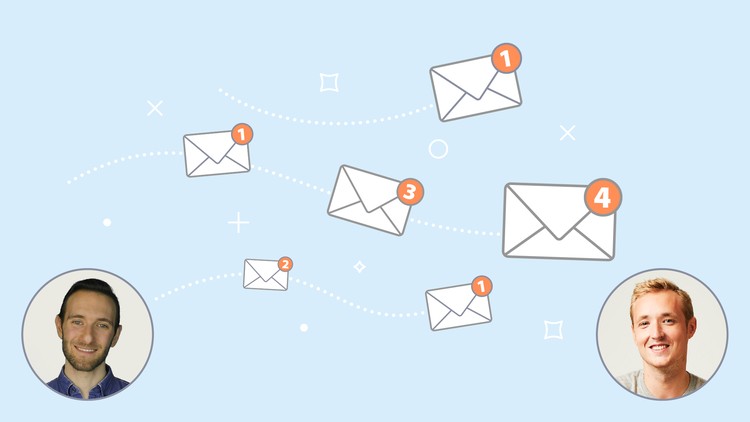Small Business Lead Generation & Cold Email | B2B & B2C
- Description
- Curriculum
- FAQ
- Reviews
- Grade

If you want to make any idea a successful one, you’re going to need some outside help. Whether it’s finding customers or just expanding your contact list, cold emails are the way to go. In this easy-to-follow course, we’re going to focus on building a lead generation campaign that will grow your business, your network, and your opportunities.
Cold email may have built up a bit of a bad reputation, but that’s only because people don’t know how to do it well. When used properly, the technique opens up access to any individual in the world, whether that’s the average shopper or a Fortune 500 CEO.
Need investors or clients for your business? Use cold email.
Need interviews for your podcast? Use cold email.
Simply want to meet someone you find fascinating? Use cold email.
You may run a small retail business or work on the sales team at a startup. You may just want to gauge interest in a business idea you’ve conjured up. Whatever it is you’re trying to do, the lectures in this course will teach you how to reach out to people and capture their attention instantly.
We’ll take you through the entire cold email process from figuring out your target audience and building a hit list to effective copywriting and follow-up techniques. Campaigns can be a rollercoaster, so we’ll also show you what to do when things aren’t going your way. Plus, you’ll learn the best software to use and how to automate the most time-consuming parts — even if you have no budget at all.
This course focuses equally on B2B and B2C sales with techniques and customizations for both scenarios. So whether you want to rake in those customers or secure a million dollar deal, you’ll walk away with a strategy that works for you. All you need to start is an email account.
Included in the course
• Over 118 lectures, teaching you how to run a cold email campaign from start to finish.
• Over 6 hours of instruction.
• Over 3 hours of behind-the-scenes practice lectures.
• 3 successful case studies.
• Tips and tricks from experts.
• Watch a live campaign run from beginning to end.
About your instructors
Evan Kimbrell has 20 courses on Udemy with over 630,000 students from 180 countries. His courses primarily focus on business, entrepreneurship and growth marketing. In 2013, Evan started the digital agency Sprintkick and used cold email techniques taught in this course to grow his business to a multimillion dollar run rate within the first year.
Zach Valenti is a creative entrepreneur and YouTuber. He’s built extensive campaigns with cold email for his own consulting business as well as his critically acclaimed podcast, Wolf 359. He’s used cold email to run a podcast, sell mental health awareness hardware to universities, and find clients for his videography consulting business.
-
1Course Overview
If you're a startup or small business, you're going to be doing plenty of cold emailing. This course gets into the nitty gritty of generating leads, including what to do when things don't seem to be going your way.
Covered in this lecture:
How to make the most of the course.
An overview of the topics we’re going to be covering.
-
2Join our community on Slack!
-
3What cold email looks like (awful emails we've gotten)
Cold email generally has a bad reputation. And that’s because most people suck at it. Sometimes, it’s unpersonalized and reads as spam. Sometimes, it’s so poorly written that you literally have no idea what the company is trying to sell. Here’s a few examples.
Covered in this lecture:
Examples of badly written cold emails.
Explanations of why they’re unsuccessful.
How a good cold email should make readers feel.
-
4336 templates for subject lines & cold email body copy
-
5Getting into the mindset & myths
There are a few myths surrounding cold emailing. Namely, that no one wants to receive them. Most of them, however, simply aren’t true.
Covered in this lecture:
The myths about cold emailing and why they’re myths.
The number one rule to remember when crafting a cold email.
-
6Review sheets & resources - all in one PDF!
-
7Intro to targeting
Figuring out the kinds of people you want to target may be a boring step, but it’s a crucial one. If you miss this stage, you could create some serious issues later on.
Covered in this lecture:
Why targeting is so important.
What can happen if you fail to target appropriately.
-
8Ideal Customer Profile (ICP)
To effectively target people, you need to know exactly who it is that you're looking to reach out to. Building a customer persona is a great way to do just that.
Covered in this lecture:
What a customer persona is and why it's useful.
How to put a customer persona together using logic.
-
9Building personas off data
Creating a customer persona through guesswork may require a little tweaking further down the line. But if you already have customer data, you can go one step better.
Covered in this lecture:
What customer data to use to build a customer persona.
How to use this data to target potential new customers.
-
10DIY threading
If you're looking to target a small group of people, threading is your best bet. It's simple, straightforward and shouldn't take up too much of your time.
Covered in this lecture:
The process of threading and how it can be used to figure out who to target.
Real-life examples.
Pros and cons of the technique.
-
11Practice - Building personas
Practice time. We're going to show you exactly how to build a customer persona, taking everything you've learnt from previous lectures into account.
Covered in this lecture:
Walkthrough of how to build a customer persona using real data and a theoretical company.
How to use this customer persona for a cold email campaign.
-
12How companies are broken down
The last thing you need to think about when targeting is how to find the best person to target within a company itself. Obviously, this mainly applies to B2B.
Covered in this lecture:
How company hierarchies work.
Which job roles fall into each section.
-
13What level do you target
Let's dive a little deeper into B2B targeting. Now you know how company hierarchies work, you need to determine which job role to target. Remember: going straight to the top isn't always the best move.
Covered in this lecture:
How to use a company hierarchy to figure out who to target.
Key things to remember during this process.
Useful examples and strategies.
-
14Review & Recap: Section 3
-
15Prospecting 101
Now, you need to make a list of exactly who you’re going to be cold emailing. Don’t get too ahead of yourself; names are all you need right now.
Covered in this lecture:
The definition of prospecting.
A brief overview of what the process involves.
-
16Building a hit list
A hit list is the spreadsheet that will store every piece of information relating to your prospective customers. How do you set one up? It's super simple.
Covered in this lecture:
What a hit list is.
What software to use to create it.
How to lay it out, whether you're B2B or B2C.
-
17Using Airtable for your hit list
If you're looking for a little more functionality than a simple spreadsheet provides, consider Airtable. Part spreadsheet, part CRM database, it offers tons of time-saving features.
Covered in this lecture:
The features that Airtable offers.
How much it costs.
Examples of how to arrange your hit list using Airtable.
-
18Where to mine - overview
Time for the mining to begin. The process can work in one of two ways, depending whether you're a B2B or B2C business.
Covered in this lecture:
An introduction to the two directions of mining.
An overview of what the next few lectures will cover.
-
19Mining with LinkedIn (free) - B2B/B2C
LinkedIn is one of the easiest places to mine potential customer names. The best part is that you don't have to pay for most of it.
Covered in this lecture:
The process of using LinkedIn to mine for free.
Different filters and strategies to narrow down your search.
-
20LinkedIn Sales Navigator (paid) - B2B/B2C
LinkedIn's premium mining tool will cost you, but its additional features may well be worth the cash. Here's why.
Covered in this lecture:
The difference between free LinkedIn and the Sales Navigator option.
How much the premium version will cost you.
Features you can use to your advantage.
-
21Mining with Google
Google is another free mining tool. Use it the right way and you can find all the company contacts you'll ever need.
Covered in this lecture:
How to use Google to mine for companies.
Example of how it's done.
-
22Using press releases for mining - B2B
Still struggling to find the name of a person from a particular company? Press releases are your last resort.
Covered in this lecture:
How to use press releases to find people within specific roles.
Ways to use Google to do this.
-
23Award winner mining - B2B
Targeting award-winning businesses is a good move. Not only will an award give you a reason for reaching out to a company but it will also make your business look great if you win the company over.
Covered in this lecture:
Why you should mine highly rated businesses.
How to effectively use Google to do this.
-
24Conferences and attendee lists - B2B/B2C
There's a conference for everything these days. Who attends, speaks at and sponsors these events can make great targets for your B2B or B2C cold email campaign.
Covered in this lecture:
Two different ways to mine from conferences.
Quick and easy strategies to help you do this.
-
25Presentations, slides and publications
Academic-type people are likely to have created a presentation or contributed to a publication at some point in their career. Here's how to use them to your advantage.
Covered in this lecture:
How to use presentations and publications to source contact details.
More benefits of this method.
-
26Using directories - B2B
People that run a business will have been listed in at least one online directory. Use the right search criteria and you've got yourself a lead list.
Covered in this lecture:
How to use online directories for mining.
Examples of reliable sites to use.
How to narrow down your search.
-
27OPTIONAL: Using communities for mining - B2C
Online communities are formed of people with mutual interests. If you're a B2C business, these groups and forums are a great way to connect.
Covered in this lecture:
How to find online communities focused on your area of interest.
Pros and cons of this mining method.
-
28Twitter keywords - B2C
Twitter's advanced search function is a secret to most people. But it's surprisingly useful when looking for cold email contacts.
Covered in this lecture:
What Twitter can be used for.
How to navigate the advanced search function.
How to sort through the results.
-
29Exporting competitors' followers on Twitter - B2C
Checking out who follows your competitors will give you plenty of names to reach out to. Here's how to obtain that list effortlessly.
Covered in this lecture:
How to find competitor businesses on Twitter.
How to export their follower list and add it to your spreadsheet.
-
30Personal network - how and when to use it
Don't forget to consider the people you know and how they may be able to introduce you to potential prospects. Not everyone will be useful, but there may be a few hidden opportunities.
Covered in this lecture:
Two ways to use your personal network in the mining process.
What to avoid doing.
-
31Prospecting best practices
When prospecting, you need to build a system that can be repeated over and over again. After all, a business always needs new customers.
Covered in this lecture:
Two methods of prospecting and how they work.
Reasons to consider each.
-
32Cold calling
When you can't find a person's contact email anywhere, the only thing left to do is hop on the phone. Cold calling may seem scary, but it can be effective if done well.
Covered in this lecture:
When and who to cold call.
Three situations you're likely to find yourself in when cold calling.
-
33Follow along - Scripts for informational cold calling
Not sure what to say when making a cold call? Don't panic. Instead, follow these simple scripts.
Covered in this lecture:
Scripts for various cold calling scenarios.
What to do when you don't get the information you want.
-
34Practice - Cold calling - Making a real cold call
Here's an example of a real cold call. Remember your goal is to get as much information as you possibly can.
Covered in this lecture:
Recording of a real-life cold call.
Review of the call's success.
-
35Practice - Mining
Now's the part where we put all of our mining knowledge into practice. Watch to see exactly how to use LinkedIn, Google and more to find contacts for a cold email campaign.
Covered in this lecture:
A real-life walkthrough of the mining process.
Explanations of the decisions that we make.
-
36Review & Recap: Section 4
-
37How email hunting works
Gathering emails isn’t the most exciting task, but it’s one you should spend some time doing. Luckily, the process isn’t that difficult.
Covered in this lecture:
How the spectrum of email hunting works.
How the majority of email addresses are laid out.
-
38Using Email Permutator + Mailtester
If you don't have much budget to spare, there are plenty of free ways to find and verify a person's email. Here are two of the best.
Covered in this lecture:
Free tools to use to find a person's email address.
How to verify if the address exists.
-
39Hunting for emails with Hunter.io
Hunter.io is a more accurate way to embark on the email quest. If you're a fan, you don't even have to leave the site to send your cold emails.
Covered in this lecture:
What Hunter.io can do.
How to use all of its features.
How much it will cost you.
-
40Using Voila Norbert
Voila Norbert is yet another email hunting tool. It's not the cheapest service around, but it's probably the quickest.
Covered in this lecture:
Basic and more advanced features of Voila Norbert.
How much it will cost you.
-
41How to find email addresses of social media profiles
Some social media users freely share their contact details. Others are a little more secretive. Here's how to find the emails of Twitter users you're interested in.
Covered in this lecture:
How to source email addresses of Twitter users.
Various strategies to help achieve this.
-
42Tricks for when you're not sure
Sometimes, you will fail to find a person's email or have more than one potential address. If you've reached the end of the road, don't give up. Use these tips and tricks for one last go.
Covered in this lecture:
What to do if you can't find an email address.
Tips for when you have more than one email for a prospect.
-
43Alternatives to email
From personal social media messages to contacting a generic company email, there are several options to consider when email hunting just isn't working.
Covered in this lecture:
A list of options to try when you can't find a person's email.
Which options tend to be the most effective.
-
44Practice - Prospecting for our interview campaign
Here, we show you exactly how to go about the prospecting process, from start to finish. There's the easy and the hard way; the free and the costly.
Covered in this lecture:
Real-life examples of prospecting.
Walkthrough of the various methods available to you.
-
45Review & Recap: Section 5
-
46Why these tools are different
So you now know how to search for individual emails. If you don't know the specific person you're looking for, you'll need to try a different technique.
Covered in this lecture:
Introduction to the B2B email hunting method.
-
47Using Datanyze
Datanyze is one tool that lets you find all of the email addresses within one company. Bonus: it's (mostly) free.
Covered in this lecture:
How to use Datanyze to find company emails.
Other useful information Datanyze can give.
-
48OPTIONAL: Using The Harvester
The Harvester is one for the more technical people out there. With a little coding knowledge, it'll help with any B2B email search.
Covered in this lecture:
What The Harvester is and how it works.
How to use it to find business emails.
-
49Intro to scaling
The last thing you want is to spend all of your time mining and prospecting leads. That’s where scaling up the process comes in. In this section, we’re going to focus on two methods that have proven to be the most effective.
Covered in this lecture:
The two best ways to scale up the mining process.
A brief introduction to the tools that can help you do this.
-
50The 4 rules of outsourcing
Of course, there are some important things to remember when it comes to outsourcing. In a nutshell, going cheap isn't always the best way.
Covered in this lecture:
Four rules to stick to when outsourcing mining and prospecting.
Why these rules are so important.
-
51Intro to Freelancer
If you want to outsource your work, Freelancer is one of the easiest sites to use. Here's a few reasons why.
Covered in this lecture:
An overview of how Freelancer works.
How to find people to hire.
How to communicate with people you hire.
Tips and tricks to remember.
-
52Writing a job post
Writing a decent job post will require a little effort. The more information you give at the start, the less time you'll spend fixing things later on.
Covered in this lecture:
What elements make up a good job post.
How to write one on Freelancer.
Pros and cons of paying a fixed or hourly rate.
-
53Going over your bids & setting a trial
Once you post your job ad on Freelancer, you'll start receiving bids pretty quickly. To weed out the good from the bad, give candidates a trial.
Covered in this lecture:
How to filter job candidates using a trial.
What makes a good trial.
-
54Bulk prospecting / buying leads
Buying leads in bulk is a quick alternative to hiring freelancers — especially if you're doing a B2B campaign. There are so many sites out there offering this kind of data, so be wary of a few things.
Covered in this lecture:
When bulk buying leads could come in handy.
Various sites that offer this tool.
Tips and tricks to help the process.
-
55Review & Recap: Section 7
-
564 useful copywriting concepts
Writing effective copy is harder than it looks. Throwing a bunch of words onto a page isn’t going to get you or your product far, so here are a few acronyms to keep in mind.
Covered in this lecture:
What good copywriting should do.
An introduction to four reliable copywriting methods.
-
57The AIDA formula
The AIDA formula is a tried-and-tested way of marketing a business or product. Follow the sequence and you'll be winning over clients in no time.
Covered in this lecture:
What AIDA stands for.
How each step works.
How to put each part of the formula into practice in a cold email.
-
58UVP
Your unique value proposition (or UVP) should be the focus of your cold email campaign. Understanding what it is and acquiring the skill to express it in your copy will put you on the path to success.
Covered in this lecture:
What UVP is and the four parts that go into it.
Why it's so important in cold email campaigns.
Real-life examples.
-
59The CBI framework
How you write your copy will depend on what you're selling and who you're selling it to. Saying that, there is a specific framework you can follow.
Covered in this lecture:
The three different approaches of copywriting.
Real-life examples of these frameworks.
-
60Emotion based copywriting
The last thing you want is for your recipient to view your email as a chore. To avoid this, add some kind of emotion into your copy.
Covered in this lecture:
Why emotional triggers are necessary for success.
Eight emotions to think about when writing copy.
-
61Review & Recap: Section 8
-
62Subject lines
An email subject line is like a book cover. If it looks boring, no one's going to read its contents. Luckily, there is an art to crafting a great subject line.
Covered in this lecture:
What makes a great subject line.
Some dos and don'ts to remember.
-
63Subject line templates for cold email
A compelling subject line will engage the reader within seconds. Whether you want to ask them a question or simply show that you have something in common, here's a few templates to keep in mind.
Covered in this lecture:
Email subject line templates.
Why each template works so well.
-
64Practice - Subject lines
Time to try out some subject lines. Here, we show you some real B2B and B2C examples that are likely to work well.
Covered in this lecture:
Examples of real B2B and B2C subject lines.
-
65Practice - Rewriting bad headlines
So many cold emails have bad subject lines. Let's try rewriting some to see the pitfalls to avoid in the future.
Covered in this lecture:
Examples of bad email subject lines.
How to rewrite and improve them.
-
66Practice - Writing subject lines for our interview campaign
You'll probably want to try out a couple of subject lines. Here's a few we went with for our very own cold email campaign.
Covered in this lecture:
A walkthrough of the process of creating subject lines for a real-life campaign.
Why we made certain choices.
-
67Review & Recap: Section 9
-
68Intro to body
So you’ve sorted the subject line. Now it’s time to take a look at the body copy of your cold email campaign. Figure out your goal and the rest should come naturally.
Covered in this lecture:
What good body copy should do.
Examples of cold email goals and how to figure out your own.
-
69Length, spacing, punctuation
Before you get into the actual content of your campaign, you need to be au fait with some of the technical stuff. After all, you don't want people to find it difficult to read your email.
Covered in this lecture:
How long a cold email should be.
How many sentences there should be in a paragraph.
Basic punctuation and grammar tips.
-
704 parts of every cold email
Cold emails can generally be broken down into four parts. Each part has a purpose, so here's how to use them to your advantage.
Covered in this lecture:
How to structure a cold email using four distinct sections.
The function of each part.
-
713 golden rules of cold email
If you're completely stuck, don't worry. Remember these three cold email rules and you're guaranteed a successful campaign.
Covered in this lecture:
Three rules to remember when writing a cold email.
The importance of each rule.
-
72How to address your prospect
How you address the person you're emailing can be the difference between a read or a trash. Here's a few things to keep in mind.
Covered in this lecture:
What you want to convey in your address.
How to find out which name your recipient likes to go by.
-
73The Hook
A good hook will immediately grab your reader's attention. Write a bad one and you'll probably lose them forever.
Covered in this lecture:
The definition of a hook and what it's there to do.
How to write a good opening sentence.
Techniques to fall back on if you're stuck.
-
74The Bridge
The next part of your cold email is the bridge. It's there to show your reader what you're offering. Just try not to make it too long.
Covered in this lecture:
What a bridge is and does.
How long it should be.
Some effective bridge examples.
-
75The Pitch
So you've perfected your bridge. Unfortunately, it won't be of much use if it leads to nowhere. That's where the pitch comes in.
Covered in this lecture:
What a pitch is and why it's so important.
What a pitch should contain.
How long a pitch should be.
Example of a successful pitch.
-
76The CTA
No idea what CTA stands for? Come right this way to get the lowdown on the most instructive part of your cold email. Figure this part out and the rest should come naturally.
Covered in this lecture:
What CTA means.
How to fit a CTA into your cold email.
Examples of good CTAs.
-
77How much do you customize?
You may not have the time or resources to send out hundreds of bespoke emails. But personalising them in some way could land you the result you're looking for.
Covered in this lecture:
Three levels of email customization.
Pros and cons of each one.
-
78Sending emails from company or personal email
Deciding whether to send your cold emails from a personal or company address depends on what you're trying to sell. Here's a few helpful pointers.
Covered in this lecture:
The difference between using a company or personal email address.
When it's best to use a company address and why.
-
79Using spintax to sound more personalized
Spintax is a quick and easy way to customize your emails. Ensure the right info is in your hit list and you're good to go.
Covered in this lecture:
What spintax is.
What it's used for.
How to incorporate spintax into your cold email campaign.
-
80How to handle "contact@ / info@" email addresses
If you haven't been able to find someone specific to reach out to, you may have to contact a generic company address. Here's what to do in that situation.
Covered in this lecture:
What to do when you don't have a specific contact.
How to handle this with both large and small businesses.
-
81Practice - Rewriting bad body copy
Reworking other people's emails is a good training technique. Figure out where they went wrong and you won't make the same mistake.
Covered in this lecture:
Examples of unsuccessful body copy.
Where they went wrong.
How to rewrite them to a much higher standard.
-
82Practice - Rewriting bad cold email from Perspectivo
Here, we're going to take a real bad email that we were sent and rewrite it from start to finish. That's subject line to CTA.
Covered in this lecture:
Understand how a cold email goes bad.
Understand how to correct those wrongs.
-
83Practice - Sample email for our interview outreach (Evan)
Now, we're going to show you how we wrote the cold emails for our very own campaign. First up is Evan's technique.
Covered in this lecture:
Insight into how Evan's cold email process works.
Explanations for the decisions he made.
-
84Practice - Sample email for our interview outreach (Zach)
Zach takes you through his cold email process, explaining why he does what he does and how to avoid the pitfalls.
Covered in this lecture:
How Zach wrote his cold email from start to finish.
Why he chose this particular approach.
-
85Review & Recap: Section 10












